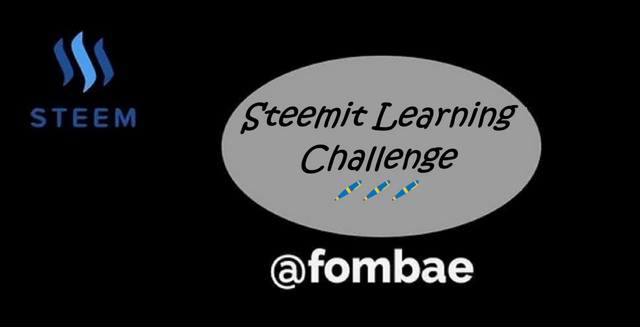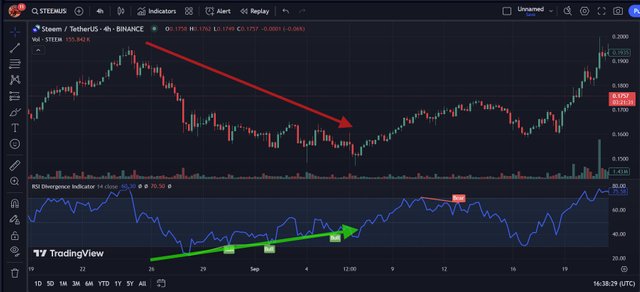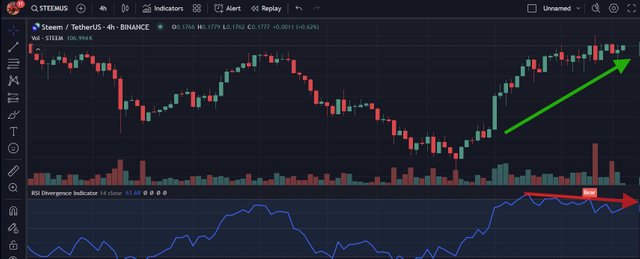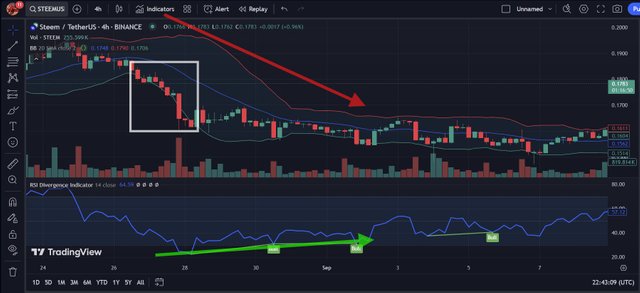Advanced Technical Analysis with Divergence Trading

Greetings Steemit friends
Explain the Concept of Divergence in Trading
Divergence in Trading is the situation in the market where the price and an applied technical oscillator indicator are moving in opposite directions. With this opposite direction movement for the market of an asset can't help a trader to predict possible changes in market trend. Most traders used Divergence in Trading to spot weak trends and potential reserves in the market. With Divergence in Trading, we can start preparing for a reversal in market direction and be able to get entry and exit points in the market. There are two main types of Divergence in Trading, Regular and Hidden Divergence. I will be working with the RSI divergence indicator.
- Regular Divergence:
Regular Divergence is a situation where the price action and the oscillator indicator are moving in opposite directions with a possible reverse trend to occur. This could be a bullish or bearish trend going in the opposite direction.
Bullish Regular Divergence is when the market price forms a lower low and the oscillator forms higher lows. At this point, even though the price continues to fall. There is a possibility of a reversal as the momentum to the fall direction is weak. This is a signal to tell a trader to initiate a possible buy as this could be the end of the downward trend.
Bearish Regular Divergence is when the market price forms higher highs and the oscillator forms lower highs. At this point, even though the price continues to rise. There is a possibility of a reversal as the momentum to the rise direction is weak. This is a signal to tell a trader to initiate a possible exit as this could be the end of the upward trend.
- Hidden Divergence
Hidden Divergence is a situation where the price action and the oscillator indicator are moving in opposite directions with a possibility of the trend continuing in the same direction. This is the situation to predict the resistance of a current trend, which can help the trader decide to hold on or exit the market.
Bullish Regular Divergence is when the market price is from a higher low and the oscillator forms lower lows. At this point, the price shows a sign of reverse. There is a possibility of a bull trend to resume and continue in the same direction.
Bearish Regular Divergence occurs when the market price forms a lower high and the oscillator forms a higher high. At this point, the price shows a sign of reverse (bull). A bear trend may resume and continue in the same direction.
- Discuss the significance of each type
Regular divergence can be used to spot exit points before the market reverses.
Regular divergence can be used as an early sign of when the market is about to change.
Regular divergence can be used as a confirmation tool to enter or exit the current position.
Regular divergence can be used as a signal for early detection that buying pressure is fading.
Hidden divergence can be used to spot continuation in the market.
Hidden divergence can be used to hold the trader to stay in the market.
Hidden divergence can be used as a confirmation tool to stay in the current position.
Hidden divergence can be used as a signal the momentum is weak, but there will be a possible rebound.
With its significance in Divergence in trading, it can be easy to get the support and resistance zones in the market. To be more efficient, combining other indicators can be a great step in trading.
Identifying Divergence with the RSI
I will be using RSI (Relative Strength Index) to identify the trading strategy for a bullish or bearish divergence. RSI (Relative Strength Index) is an oscillator that measures the speed and the actions of the market movement. It oscillates within an interval of 0 and 100. Whenever it goes above 70, that means the asset is overbought. Whenever it goes below 30, that means the asset is oversold.
Divergence now will be when the price is moving in one direction and RSI (Relative Strength Index) is moving in the opposite direction. This means that the momentum behind the price is weakening and slowing down, which may lead to a potential reversal in the market.
As mentioned in the first question, there are two types of divergence. The bullish and the bearish divergence be it in the regular or hidden.
Bullish Divergence: This is when the market price makes a lower low, while the RSI makes a higher low. At this point, the bearish momentum is weakening and possible reversal by a gradually bullish momentum. Here, we see the price of steem making a lower low (downtrend), while the RSI is making a higher low (upward trend). The chart below shows that the selling momentum is not strong enough even though the price is falling.

Bull divergence can give a good opportunity for a trader to initiate an entry point. As the RSI is indicating that bearish momentum is weakening and breaking above can be confirmation to trigger an entry point.
Bull divergence can be used to manage risk and stop loss. As the price falls and the RSI drops from its recent lows, then a trader needs to be careful as the bullish might be invalid.
Bearish Divergence: This is when the market price makes a higher high, while the RSI makes a lower high. At this point, the bullish momentum is weakening and possible reversal by a gradually bearish momentum. Here, we see the price of steem making higher highs (upward trend), while the RSI is making lower highs (downward trend). The chart below shows that the buying momentum is not strong enough even though the price is rising.

A bearish divergence can give a good opportunity for a trader to initiate an entry point. The RSI is indicating that bullish momentum is weakening and dropping below 70 is a good signal to sell.
A bearish divergence can be used to manage risk and stop loss. As the price seems to be forming a higher high and the RSI moves from its recent swing high, then a trader can confirm an invalid bearish trend.
Bearish divergence is a key feature used to take profit. The reward ratio depends on the trader's level of risk taken and will help make a profit.
Combining Divergence with Other Indicators
Combining divergence with other indicators helps us have a more robust and some level of accuracy to signal while reducing possible false signals. For this case, I will make use of the Bollinger band which we looked at last week. The Bollinger band is made of three bands, the upper band, lower barns, and the SMA (simple moving average). The upper band indicates possible overbought while the lower band indicates possible over-sold in the market. As for RSI, above 70 indicates a possible overbought while below 30 will indicate a possible oversold.
Bullish Divergence with RSI and Bollinger Bands
The price movement is in the downward trend, forming lower lows. The RSI forms a higher low, showing that selling momentum is weakening. At this point, the downward trend is losing momentum and a potential reverse to an upward trend.
Adding the Bollinger bands, we can see the lower bands touching the price candlesticks. This is confirmation that the market is in an oversold condition and is in a period of low volatility. The upper band is far from the candle sticks. So traders can predict a potential breakout to an upward trend confirming the potential reversal.

- Market Decision
Entry Point: As the SMA cuts below the candles, the lower band starts to touch the price candles and the upper bands away from the candles. This can be a confirmation signal to trigger an entry point and initiate a buying action. Combining RSI higher high, we have more confirmation of the trend reversal to get into the market.
Stop-loss: We can place stop loss below the recent swing low in case the reversal is not valid.
Take Profit Signal: We can target the next resistance point while making use of the risk-reward ratio to determine our take-profit level.
Bearish Divergence with RSI and Bollinger Bands
As the price movement is in the upward trend, forming higher highs. The RSI forms a lower high, showing that buying momentum is weakening. At this point, the upward trend is losing momentum and a potential reverse to a downward trend.
Adding the Bollinger bands, we can see the upper bands touching the price candlesticks. This is confirmation that the market is in an overbought condition and is in a period of low volatility. The lower band is far from the candle sticks. So traders can predict a potential breakout to a downward trend confirming the potential reversal.
- Market Decision
Entry Point: As the SMA cuts above the candles, the upper hand starts to touch the price candles and lower bands away from the candles. This can be a confirmation signal to trigger an entry point and initiate a selling action. Combining RSI lower highs, we have more confirmation of the trend reversal to get into the market.
Stop Loss: We can place stop loss below the recent swing high in case the reversal is not valid.
Take Profit: We can target the next resistance point while making use of the risk-reward ratio to determine our take-profit level. This left for you to decide how much risk you are willing to take.
Developing a Divergence-Based Trading Strategy
After looking at comn=bine other indicators to reduce false signals and identify potential reversal or trend continuation. Divergence in trade helps traders to strategy and take advantage of when a current trend momentum is weakening. The trader will start by identifying the current market divergence, which can either be a Bullish or Bearish divergence.
- Identify Divergence
Bullish Divergence (possible Entry Signal)
When the price forms a lower low (downward trend) and the RSI forms a higher low. This is a possible indication of slowly strong momentum for a bullish trend. From the chart, RSI moved from below 30, which was its first lower low, and rose above 30 creating a new low. At this point, we can start confirming a divergence in the market as the bullish momentum looks to be going stronger.
To be able to filter and reduce possible false signals, let's make use of the Bollinger bands technical analysis. As soon as the lower band starts touching the candle sticks, there is a potential breakout. As the SMA cuts below the candles, lower bands start moving away from the candles. This can be a confirmation signal to trigger an entry point and initiate a buying action.
Bearish Divergence (possible Entry Signal)
When the price forms a higher high (upward trend) and the RSI forms a lower high. This is a possible indication of slowly strong momentum for a bearish trend. From the chart above, the RSI moved from above 70, which was its first higher high, and fell below 70 creating new highs. At this point, we can start confirming a divergence in the market as the bearish momentum looks to be going stronger.
To be able to filter and reduce possible false signals, let's make use of the Bollinger bands technical analysis. As soon as the upper band starts touching the candle sticks, there is a potential breakout. As the SMA cuts above the candles, upper bands start moving away from the candles. This can be a confirmation signal to trigger an entry point and initiate a buying action.
- Confirm Criteria
Bullish Divergence: Price is forming lower lows and oscillators are forming higher lows, as you look for increasing volume. Look for strong support levels, which turn out to be forming s hammer candlesticks. At this point, the divergence can confirm a potential upward trend in the market.
Bearish Divergence: Price is forming higher highs and oscillators are forming lower highs, as you look for decreasing volume. Look for strong resistance levels, which turn out to be forming shooting star candlesticks. At this point, the divergence can confirm a potential downward trend in the market.
- Apply Exit Strategy
Bullish Divergence: Entry point when the price forms a lower low, and the RSI forms a higher low ( which the market bearish momentum is weak). Make sure that the RSI is below 30 at the first low and then move above to create the next low. Using Bollinger bands, the lower band is moving on the candle sticks which is a signal of a potential breakout. Such a situation of Bullish Divergence can be comfortable for a long entry. The moment the RSI reaches overbought (above 70), the market starts generating a weak upward momentum. It is a confirmation to exit long positions and take profit.
Bearish Divergence: Entry point when the price forms a higher high, and the RSI forms a lower low (in which the market bullish momentum is weak). Make sure that the RSI is above 70 at the first high and then move below 70 to create the next high. Using Bollinger bands, the upper band is moving on the candle sticks which is a signal of a potential breakout. Such a situation of bearish Divergence can be comfortable for a short entry. The moment the RSI reaches oversold (below 70), the market starts generating a weak downward momentum. It is a confirmation to exit short positions and stop loss.
- Reduce False Signals
Make use of other technical indicators and stay away from low-volume markets. Apply longer-term RSI, which can help reduce false divergence during short-term market noise.
Just like all technical indicators, there are limitations to look out for when applying them. To adopt best practices and make sure you are making the best decision.
- Limitations of Divergence Trading
Late confirmation and false signals
Divergences are not 100% reliable on their own, as a divergence can suggest a potential reversal while it will continue in the same direction. This can lead to suggesting a false signal, pushing a trader to enter a position early. By doing so the market continues in the same direction, which results in a loss.
To avoid situations like this, it is important to combine divergence with other indicators. Making use of support and resistance level indicators can lead to better conformations. Making use of the hammer for bullish divergence can help confirm potential reversal.
Low volume market
Divergence during low-volume conditions shows a lack of liquidity and can cause prices to make unreliable divergence signals. Low-volume movements can sometimes trigger shape and unexpected price action to create a reversal.
To avoid a situation like this, waiting for a divergence signal to show up in an increasing volume is important. Here a trader can confirm that reversal is backed by a market interest.
Lower time frame
Using short time frames will create too much noise on the chart, initiating a lot of false signals in the market. Lower time frames can create many divergences which are not reliable.
To avoid a situation like this, traders can make use of higher time frames, which will give a better accurate divergence signal.
- Best Practices for Using Divergence
Make use of multiple confirmation tools to increase the reliability of divergence.
Make use of price actions, as they can give potential breakout signals. That is above resistance for bullish divergence and below support for bearish divergence.
Wait for conformations before making any market decision such as entry or exit points.
Apply risk management in position sizing when placing stop loss. That is making use of the most recent swing high or low to place stop loss.
Cheers
Thanks for dropping by
@fombae